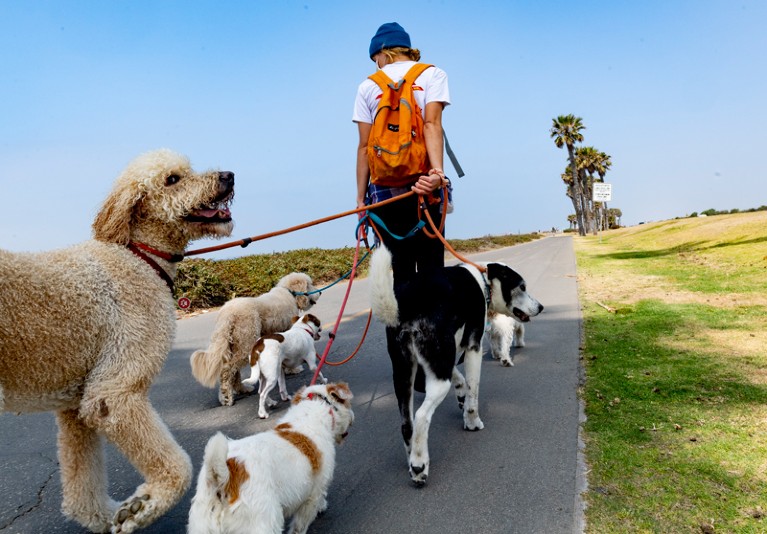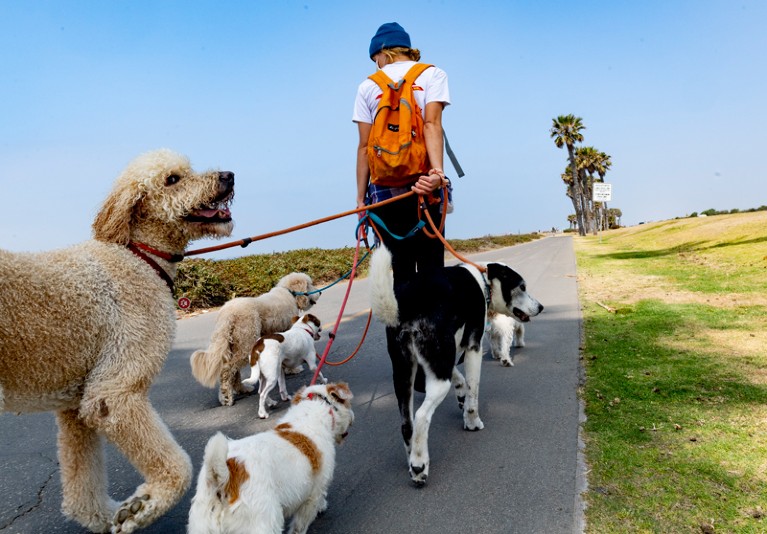

Researchers have pinpointed genetic variants linked to different dog behaviours.Credit: Paul Bersebach/MediaNews Group/Orange County Register/Getty
Is your dog scared by a plastic bag flapping in the wind? When a stranger comes to the door, does it bark, hide or look for you? Does it chase squirrels?
A study that combined 46,000 answers to these and other questions with DNA sequences from more than 4,000 dogs — including domestic and wild canines — has pinpointed genetic variants linked to characteristic dog behaviours.
It is a Herculean effort to untangle the complicated genetics woven by hundreds of years of dog breeding, and to catalogue the genetic changes — many of them involved in neurodevelopment — behind the behavioural characteristics of different breeds.

Big dog, little dog: mutation explains range of canine sizes
“There are about 350 dog breeds recognized in the world, and each one is a different story,” says geneticist Elaine Ostrander at the US National Human Genome Research Institute in Bethesda, Maryland, and an author of the study, which is published on 8 December in Cell1. “You can’t just group them together like you can humans.”
Each of those unique histories has left its footprint in the genomes of specific breeds. Some breeds are heavily influenced by one particular male that did well in a dog show and had its sperm frozen and widely distributed. Others might have been influenced in a different way: for example, the populations of some large dog breeds decreased dramatically during times of war or famine, when there was not enough food to feed them. Sometimes breeders then mixed different canine lineages in an effort to reintroduce characteristics lost to the remaining population.
Dog DNA
The complexity of these stories makes it difficult to trace the genetic origins of behavioural traits, so Ostrander and her colleagues decided to scrap conventional breed categories and instead use DNA sequences to group dogs into genetic lineages. The team analysed DNA from almost 4,300 dogs, including 2,800 purebreds spanning 226 officially recognized breeds. The approach — which also included DNA from mixed-breed dogs, semi-feral dogs and wild canids from four continents — yielded ten distinct lineages.
From there, Ostrander and her colleagues turned to the behavioural surveys collected from the owners of more than 46,000 purebred dogs to map behavioural traits to the lineages. Members of the terrier lineage, for example, tended to show predatory behaviour and aggression towards other dogs, whereas toy dogs tended to be nervous.

Massive study of pet dogs shows breed does not predict behaviour
An analysis of DNA sequences associated with those behaviours identified a number of variants linked with the development of the nervous system. For example, variants that were common in sheepdogs — bred for their herding instincts — pinpointed a molecular pathway involved in forming connections between nerve cells. Previous studies have shown a link between two genes involved in this pathway and behaviour in which female mice gather their pups tightly together, suggesting that herding could have evolutionary roots in maternal actions to protect offspring.
The results are an exciting advance in understanding the relationships between dog lineages, says geneticist Elinor Karlsson at the University of Massachusetts Chan Medical School in Worcester. Earlier this year, Karlsson published data showing that breed is a poor predictor of an individual dog’s behaviour2.
“It’s been a real struggle in dog genetics,” she says. “This is starting to move beyond the idea of comparing one breed to another breed, and towards really looking at how behaviour maps onto the ancestry of dogs.”
Bigger variations
This study focused on small changes in DNA sequences, such as single-letter changes and small deletions or insertions of DNA. Future studies might look at other forms of genetic variation, such as larger deletions or rearrangement of chromosome segments, says canine geneticist Adam Boyko at Cornell University in Ithaca, New York.
As such studies continue to map the genetics underlying dog behaviour, one hope is that the results could inform research into neurodiversity and the biological basis for human behaviours, Boyko says. “It gives human researchers the ability to start generating hypotheses that you wouldn’t otherwise be able to have in the absence of this great model.”
Given that dogs and humans often share a home, such studies could be useful in understanding how environment shapes disease risk. “At the end of the day, dogs and humans are probably more similar to each other than they are different, if you look at the whole spectrum of animal evolution,” says Karlsson. “We can totally understand each other for most things.”